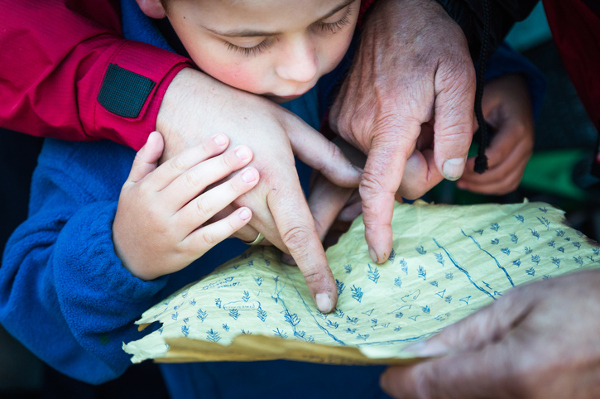5 easy ways to encourage handwriting skills (no screens involved!)

Do you remember spending hours as a child carefully drawing elaborate borders, full of patterns and colours? Can you remember hours spent on title pages with beautiful bubble writing headlines? Given the crucial role handwriting plays in a child’s literacy development, experts are keen to keep pens in hand. If you’re looking for ways to encourage your kids to put down the screens and pick up a pen, come on through for some expert tips.
Get back to basics
Louise Park is a former teacher, a best-selling publisher and author and a mum-of-two. She’s also an ambassador for BIC’s Bright Futures are Written by Hand campaign.
Louise has studied children’s literature and literacy extensively and has spent years training teachers in the field.
More recently she has produced the hit chapter book series Harriet Clare, which also serves to encourage children to pick up a pen or pencil and write or draw by hand.
“I was noticing in children, the days where they would create their own gorgeous borders and do their own bubble writing headings had gone, and they were using computers far too much,” Louise tells Babyology.
“With this perfect centred text with perfect computer-generated borders, something was being lost so I wanted to get them back to that gorgeous basic of valuing their own contributions, their own drawing and their own writing.
“In my books, Harriet will be having a problem with a friend and is trying to write her a letter and doesn’t know what to write. She then asks the reader for help and there is an opportunity for the reader to actually write a letter into the book, or to finish off a border when Harriet is stressed and feeling anxious – she suffers from generalised mild anxiety as well – so she doodles and draws like that whole adult colouring movement.
“These books really took off because they hit a chord, they were getting children back to just being kids I think, and not having that need to have everything they did look absolutely computer-perfect.”
Find the right balance
Louise says she is far from being anti-computers and has even set up an online blog where her readers can share their creations with her.
“I am up for balance, there is absolutely a role for computers in the classroom and at home for literacy but it’s about the balance and at the moment the computer push has tipped the scales too far and children are missing out,” Louise says.
“Let’s go back ten or fifteen years, there was always a group that had learning difficulties and a group that struggled, but that group has been growing and teachers are seeing more and more children falling into it. Research shows that a lack of handwriting is really impacting here – children are on devices much more and they’re not just getting a pen and paper and just writing or reading, and they’re the things I just really want to see addressed.”
Jump on the handwriting bandwagon
Louise says it is crucial to encourage children from the age of four and up to develop their handwriting.
“From the ages four to 10 the research is in, when you write by hand, reading and writing go hand in hand,” she says. “If you take writing out of the equation, it is much harder for a child to acquire literacy.”
She says the focus on handwriting needs to be as strong as it is on reading. “Since the ’80s parents have been reading to children before they go to school to help their literacy so they are all over that but they are not aware of the handwriting component,” Louise says.
“The handwriting component is so integral, when they are actually forming letters and writing them by hand scientific research shows they will commit that letter to memory more than through any other way because of the cognitive act they use.
“Then they join those letters up to make a word and join those words to make a sentence, all of that is a fundamental part of them cracking that reading code and that has been my bandwagon for a long time.”
Fun ways parents can encourage handwriting
By encouraging age appropriate activities catered to the child’s interest, parents can help children develop their handwriting skills. Here are some activities Louise suggests.
1. Treasure map

If you have a child who loves adventure and the outdoors, Louise suggests getting them to bury something in the garden and then draw their own treasure map.
2. Letters to friends
If you have a child who is all about their friends, why not encourage them to create a note (without a computer) for a friend? Get them to write or draw the note by hand and either take it to school for delivery or send at the post office.
3. Lead by example
Parents can lead the way by using pens and pencils in front of children. Louise says parents should limit the notes they put in their phones and take more hand notes in front of their children. Writing out things like grocery lists can be a fun way to involve children as well.
4. Experiment with mediums
While starting the transition to pens or pencils, Louise says parents can experiment with other mediums such as invisible ink, writing in the sand or dirt, using objects like sticks to create words to make it fun.
Personally, I have an almost four-year-old son who shows no interest in writing his name yet. Louise suggested I appeal to his super-hero obsession and draw a caped superhero in the sand next time we are at the beach and encourage my son to write his name on the cape.
Handwriting helps children retain information
For many parents, technology has already well and truly found a place in their child’s everyday life. But it is not too late to encourage a balance and, while it may be difficult at first, it will be well worth it.
Louise says while running creative writing workshops in school she noticed a big difference in the information retained by students using iPads compared to those who took handwritten notes.
“The ones who are madly scribbling notes on paper can get up and just talk willy nilly. Research also shows that when you use pen or pencil to brainstorm rather than a computer, the ideas will flow much more quickly and it’ll be much more productive.”
Louise starts her workshops by showing students her notebook full of brainstorming story notes and drawings.
“I explain to the students that I don’t actually move to my computer until I have a solid outline of my story ready to go because a lot of that idea generation is going to happen best when you are using pen and paper and squiggling all over it,” she says.
“I get them to do that now and teachers can see the difference in their productivity, and when they are ready to write it up, that’s the perfect role for a computer but the creative process needs to happen before that.”
How to encourage reluctant writers
One of the best ways to encourage a reluctant writer is to remove their writer’s block, Louise tells Babyology.
“A child who can’t come up with an idea needs a rough story outline to write to – that’s where they’ll be stuck and they’ll stay stuck – and this eats up all their time when they should be writing,” she says.
“I tell teachers, if you want them to improve their writing skills and write stories with a plot, beginning, middle and end, then removing that step is the best thing you can do for them. That is often the biggest block for a reluctant writers. If there is no idea in in their head, they freeze and feel bad about themselves.”
(This is a sponsored post for BIC)









